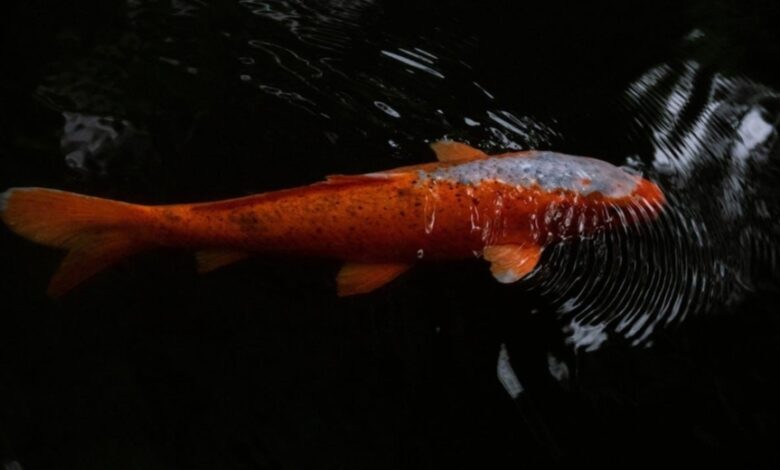
The sight of a fish swimming upside down is a strange and alarming spectacle for any aquarium enthusiast. Often, this unusual behavior points to a condition commonly referred to as swim bladder disorder, a syndrome that can affect the buoyancy and balance of your beloved goldfish. Observing a goldfish navigating its tank in such an awkward posture begs the question: why does this happen, and is there hope for the fish to recover?
Swim bladder disorder, also known as swim bladder disease, is not a disease in the traditional sense but rather a symptom or a collection of symptoms affecting the fish’s swim bladder, an internal gas-filled organ that helps regulate buoyancy. When a fish is seen swimming upside down, the swim bladder is usually not functioning properly. This can be due to various factors such as water quality, overfeeding, genetic defects, bacterial infections, or even the fish’s anatomy, particularly in fancy breeds prone to such issues.
For goldfish, especially the fancier breeds with rounded bodies, the risk of swim bladder disorder is higher. This is because their uniquely shaped bodies can sometimes impede normal swim bladder function. Factors like constipation or gulping air when feeding at the water’s surface can lead to the swim bladder becoming compressed or deformed, causing the goldfish to lose its ability to maintain proper balance and buoyancy.
While the situation may appear dire, not all hope is lost. Many cases of fish swimming upside down can be addressed with specific treatments and care strategies. Adjustments to diet, water temperature, and even incorporating fasting periods can significantly improve the condition. In some cases, a specialized treatment regimen might be necessary to combat any bacterial causes behind the swim bladder issues.
For the dedicated goldfish keeper, understanding and addressing the mystery of the upside-down swimmer is paramount. Proper care, timely treatment, and vigilant observation can often lead to a positive outcome, allowing the goldfish to regain balance and swim properly once again. To explore more about the intricacies of goldfish care and potential treatments, visit our guide on the smallest aquarium fish, which can provide additional insight into maintaining a healthy environment for your aquatic companions.
Moreover, learning about the specifics of fish breeds and their requirements is crucial to preventing this uncomfortable condition. Knowing which breeds are more susceptible to swim bladder disorders can affect both the choice of your pet and the care it receives. The journey to solve the mystery of the upside-down swimmer can be complex, but with the right knowledge and care, your goldfish can thrive in its aquatic realm.
Unraveling Swim Bladder Disorder
Witnessing a fish swimming upside down can be a perplexing and concerning sight for any goldfish owner. Swim bladder disorder, a condition, frequently causes this unusual behavior. Swim bladder disorder affects the fish’s buoyancy, leading to disorientation and an inability to maintain its normal position in the water.
The swim bladder, also known as the gas bladder, is a flexible sac within the fish’s abdomen responsible for maintaining buoyancy. When functioning correctly, it allows a fish to float effortlessly, regulate its depth, and maintain an upright position. However, if the swim bladder becomes compromised due to illness, physical damage, or environmental factors, the fish may begin to display clear symptoms of distress, including swimming upside down.
Several triggers can lead to the development of swim bladder disorder, and it’s crucial to identify them to foster recovery. Some common causes include overfeeding, consuming air when eating at the water’s surface, rapid changes in water pressure or temperature, and bacterial infections that inflame the swim bladder. Certain breeds, particularly fancy goldfish with compressed bodies, are more susceptible to this ailment due to their anatomy.
Understanding the right blend of foods and feeding techniques is essential to minimizing the risks associated with swim bladder disorder. A balanced diet rich in fibers, like peas, can help prevent constipation, a known factor in bladder issues. It’s also beneficial to soak dry food before feeding to minimize air intake.
The diagnosis of swim bladder disorder involves keen observation of the afflicted fish. Look for signs such as an abnormal swimming pattern, floating or sinking without control, difficulty remaining submerged, or a swollen abdomen. If your goldfish is swimming upside down and exhibits any of these symptoms, a swim bladder disorder could very well be the cause.
Treating swim bladder disorder starts with refining the goldfish’s environment and diet. Increased water temperature can improve digestion, and a period of fasting may help relieve constipation. In severe cases, veterinary-prescribed antibiotics may be needed to combat bacterial infections.
The prognosis for fish with swim bladder disorders varies. While many fish can recover with proper care and adjustments to their diet and environment, chronic or severe cases may necessitate ongoing management. It’s essential to continually monitor water quality, as poor conditions can exacerbate the disorder.
Prevention is invariably the optimal approach to swimming bladder disorder. Regular water tests, proper feeding practices, and awareness of your goldfish’s behavior will ensure the disorder remains a mystery rather than a reality in your aquarium.
Common Culprits Behind Buoyancy Battles
When your fish is swimming upside down, it’s a signal that it could be grappling with buoyancy issues, often stemming from a swim bladder disorder. Here, at The Goldfish Tank, we’re delving into the prevalent causes that incite these aquatic acrobatics.
Buoyancy in fish, providing the ability to float, navigate, and maintain equilibrium, is largely regulated by the swim bladder. This gas-filled organ is susceptible to a range of disturbances, commonly linked to three major factors: water quality, diet, and disease.
- Water Quality: The backbone of a healthy aquarium lies in maintaining immaculate water conditions. High levels of ammonia, nitrites, and nitrates, which can result from poor filtration and infrequent water changes, wreak havoc on a goldfish’s swim bladder function.
- Dietary conundrums: Fish swimming upside down may be experiencing digestive distress as a result of overfeeding, an improper diet, or rapid eating that results in excessive air intake. Goldfish, in particular, are prone to such issues, which can cause constipation and block the swim bladder’s ability to regulate buoyancy.
- Disease and Infection: Bacterial infections and parasitic invasions can directly influence the swim bladder. The inflammation and swelling resulting from such attacks can impair the organ’s ability to function correctly.
Identifying these underlying issues is just the start. By adopting a meticulous approach to goldfish care, aquarists can nip these problems in the bud, ensuring their cherished swimmers lead a balanced life, both inside and out.
Fish swimming upside down consistently is a visual symptom that requires immediate attention. Addressing the source of the problem often leads to a swift recovery, allowing your goldfish to swim right-side up, as nature intended. Keeping an eye on these common culprits will safeguard your fish against future buoyancy battles, ensuring your aquarium remains a harmonious hub of healthy activity.
Spotting the symptoms
When your goldfish is found swimming upside down, it is often a sign of a troubling condition known as swim bladder disorder. This common issue in fish is not only distressing to watch but also signals that your pet is struggling with its buoyancy. Recognizing the symptoms early can lead to timely treatment and recovery, ensuring your goldfish continues to thrive in its aquatic environment.
Swim bladder disorder can manifest in several ways beyond just fish swimming upside down. Fish may also swim on their sides, struggle to maintain a stable position, or fail to rise off the bottom or sink below the water’s surface. Observing these symptoms should prompt an immediate assessment of the fish’s health and living conditions.
- Buoyancy irregularities include swimming at odd angles or floating involuntarily.
- Abnormal posture: the fish may hold its fins clamped close to the body.
- Inactivity: a marked decrease in swimming or movement.
- Difficulty in feeding: fish may not be able to reach food or may spit it out.
- Enlarged belly: the fish’s abdomen may appear swollen or distended.
Determining the presence of these symptoms is crucial and sheds light on the fish’s swim bladder function. At The Goldfish Tank, we emphasize the importance of not only spotting the symptoms but understanding that they may point to various underlying causes like water quality, bacterial infections, or an inappropriate diet.
Providing the right treatment hinges on an accurate assessment of these symptoms, which, while they may sometimes be indicative of a mild issue that can be resolved with adjustments to care or diet, might also signal more serious health concerns that require professional attention. Vigilance in monitoring for these signs is paramount to preventing a minor problem from turning into a more serious one.
In cases where fish continue to exhibit difficulties swimming properly, it’s advisable to consult with a veterinarian who can properly diagnose and recommend a course of treatment. The sooner symptoms are addressed, the better the chances are for a fish to recover and return to normal swimming behavior.
By being alert to the signs of swim bladder disorder, goldfish owners can take swift action to ensure their pets receive the care they need. Balance in the water, a stress-free environment, and a nutritious diet are fundamental to maintaining healthy buoyancy in fish. Keep abreast of the latest care tips and ensure your goldfish remains a joyous swimmer at The Goldfish Tank.
Goldfish and Buoyancy
Spotting your goldfish swimming upside down can be an alarming sight, often signaling an issue with buoyancy. The swim bladder, an internal gas-filled organ that is essential for maintaining goldfish balance and position in the water, is primarily responsible for controlling buoyancy in them. When a goldfish exhibits a flipped swimming pattern, it’s typically associated with swim bladder disease, a common but misunderstood condition that affects many aquarium dwellers.
This condition doesn’t mean the end for your aquatic companion; instead, it requires swift understanding and action. Swim bladder disorder, as it’s often called, can stem from a variety of factors, including poor water quality, overfeeding, congenital defects, or other diseases. Essentially, anything that affects the normal function of the swim bladder can lead to the distressing sight of a fish swimming upside down.
Goldfish are particularly prone to bladder issues due to their unique physiology. Selective breeding has led to variations in body shapes and sizes, sometimes rendering their swim bladders more susceptible to dysfunction. This is a well-known issue with fancy goldfish because of their rounder bodies. Such a compromised swim bladder can lead to irregular swimming patterns, buoyancy issues, and the struggle to maintain a normal position in the water.
Identifying and addressing the environmental causes can often lead to improvements in your goldfish’s swimming habits. Keeping a check on your fish’s diet, ensuring the tank conditions are optimal, and watching for signs of stress are pivotal steps in preventing buoyancy issues. Goldfish with persistent swim bladder problems may require changes in their diet to include more fiber, or in serious cases, may benefit from veterinary care where specific treatments or medications can be administered.
Understanding the correlation between goldfish and buoyancy issues is vital for any aquarist. With informed care, it’s possible to manage or even correct the worrying upside-down swimming, ensuring your goldfish can lead a buoyant, balanced life.
Diagnose and treat
When your fish starts swimming upside down, it’s a signal to diagnose the issue for effective treatment. Swim bladder disorder isn’t simply about awkward swimming—it’s a sign your pet needs help. Understanding the causes and implementing the right treatment can be crucial for recovery. The first step is identifying the symptoms associated with swim bladder disease, such as fish struggling to maintain balance or floating uncontrollably.
Once symptoms are spotted, it’s essential to assess the fish’s environment. Poor water quality, abrupt changes in water temperature, and an improper diet can all contribute to bladder problems. Testing your tank’s water parameters is a must, focusing on nitrogen levels, pH, and temperature to rule out environmental factors.
Dietary causes are equally important to investigate. Overfeeding or feeding dry or improperly balanced foods can lead to bladder issues. An x-ray or ultrasound by a vet can help to confirm a diagnosis, especially to distinguish between bladder issues and other diseases with similar symptoms.
A comprehensive approach to diagnosis, considering both physical examination and environmental evaluation, is crucial for addressing fish swimming upside down. Adjustments to feeding routines or selecting the appropriate fish types suited for your aquarium size can significantly impact recovery. If necessary, medications or antibiotics may be prescribed based on a bacterial cause. Ensuring the diagnosis is accurate can pave the way to a swift recovery for your beloved fish.
Acting quickly and confidently with a thorough diagnosis and tailored treatment can ensure your fish stops swimming upside down and regains its balance and buoyancy. Remember, the sooner you spot the signs and seek to diagnose the condition, the better the chances are that your fish will comfortably swim right side up again.
Five Steps to Fish Recovery
When your beloved pet fish starts swimming upside down, it can be a startling symptom that demands immediate attention. This occurrence is often associated with swim bladder disorder, but prompt and proper care can lead to recovery. Here at The Goldfish Tank, we value the health and happiness of your aquatic friends and provide these five critical steps to help restore balance in their lives, focusing on causes like constipation, infections, and buoyancy issues.
- Assess the Environment: Check your tank’s water quality for irregularities in pH levels, ammonia, and nitrite concentrations. Regular water changes and maintaining a stable environment are vital in preventing stress that could lead to a fish swimming upside down.
- Modify the diet: An imbalanced diet may cause constipation, a common factor in bladder problems. Introduce high-fiber foods such as peas and decrease high-protein meals. Soaked floating pellets are recommended to prevent air swallowing, which exacerbates buoyancy issues.
- Implement Fasting: A temporary fast of 24 to 48 hours can help clear your fish’s digestive tract. This pause gives the swim bladder space to regain function, often solving minor buoyancy problems that result in fish swimming upside down.
- Consider Medication: In cases where bacterial infections are suspected, consult a veterinarian for the appropriate use of antibiotics. This treatment can reduce internal inflammation, thus improving bladder function.
- Adjust Buoyancy with Salt: Epsom salt baths can be a gentle remedy to relieve swelling and enable better bladder control. Refer to a trusted source for proper dosage and treatment methods to avoid additional stress on the fish.
Our comprehensive guide on different types of goldfish also highlights breeds with predispositions to swim bladder issues, offering tailored care tips to ensure your aquarium inhabitants not only survive but thrive. Remember, early diagnosis and treatment are crucial for recovery when experiencing fish swimming upside down, so be observant and ready to act swiftly.
As with any health issue, prevention is better than cure. By following a routine of quality diet management, regular water maintenance, and careful observation, goldfish enthusiasts can vastly reduce the incidence of swim bladder disorder, which leads to fish swimming upside down. Ensure your aqua-pets enjoy their swim right side up by employing these five steps and monitoring their progress closely.
Dietary Balance for Healthy Swimming
Ensuring your goldfish maintains healthy swimming patterns starts with addressing its diet, as it is essential to prevent fish from swimming upside down. A well-balanced dietary regimen is crucial for the overall buoyancy and well-being of your aquatic friend. Imbalances in nutrition can lead to swim bladder issues, one of the principal causes of erratic swimming behavior, including the distressing sight of a fish swimming upside down.
The swim bladder is a gas-filled organ that helps a fish maintain its buoyancy in the water. However, overfeeding or feeding your fish incorrectly can lead to swim bladder problems, commonly resulting in a loss of balance and an upside-down orientation in the water. To maintain your fish’s correct swimming posture, consider the following dietary recommendations:
- Avoid overfeeding: Overfeeding can cause constipation and bloating, which puts pressure on the bladder. It’s essential to follow a feeding schedule that aligns with your fish’s species-specific needs.
- Right Food Choices: Feed a variety of high-quality, specific foods suitable for goldfish, which are more easily digestible and help maintain a healthy swim bladder. The inclusion of fiber-rich options, such as peas, can aid digestion.
- Proper Feeding Practices: Soak dried foods before feeding to ensure they do not expand inside the fish’s digestive tract, which can contribute to swim bladder disorder. Floating foods should be avoided, as they can cause your goldfish to ingest air, leading to buoyancy problems.
- Monitor Fish Health: Keep an eye on your fish after feeding times to ensure they are digesting their food correctly and not showing signs of discomfort or erratic swimming.
- Regular Water Changes: Clean, well-oxygenated water is vital for healthy digestion and bladder function. Regular water changes and tank maintenance will promote a stable and healthy environment for your goldfish.
By implementing these steps, you can greatly improve your goldfish’s ability to regulate its buoyancy and thrive among the smallest aquarium fish. Remember, a balanced diet not only prevents fish from swimming upside down but also plays a significant role in preventing other health issues. Maintain a watchful eye on your pet’s eating habits and body shape, as a bloated appearance can be an early indicator of dietary imbalance, leading to bladder concerns.
To further enhance your goldfish’s health and happiness, explore a variety of suitable breeds within the goldfish community, ensuring each breed’s specific dietary needs are met for optimal buoyancy and swimming balance. A keen understanding of your fish’s dietary requirements can lead to a happier, healthier, and properly poised goldfish in your aquarium.
Stress and Swim Bladder
When you witness the unusual sight of a goldfish swimming upside down, the swim bladder often plays a critical role. The swim bladder, a gas-filled organ that aids in maintaining buoyancy, can be sensitive to various stressors in a goldfish’s environment. Understanding the link between stress and swim bladder function is vital for any goldfish keeper’s arsenal.
Many triggers can cause stress in goldfish, affecting their swim bladder health. Poor water quality, with high levels of nitrates or ammonia, can rapidly induce stress, leading to bladder issues. Sudden changes in water temperature are another stress factor that can impact the swim bladder’s functionality, causing the fish to lose balance and swim oddly. Overcrowding is also a source of stress, providing insufficient space for your goldfish to swim freely, consequently affecting buoyancy control.
Furthermore, incorrect feeding practices stand as a significant stressor. Overfeeding can lead to constipation, which exerts pressure on the swim bladder, while feeding improper diets can cause nutrient deficiencies or digestive issues, further distressing the swim bladder. To help alleviate these issues, ensuring a balanced diet containing the right amount of fiber is crucial for maintaining goldfish buoyancy and global health.
- Always assess water quality parameters using appropriate testing kits and keep the water pristine.
- Maintain stable water temperatures, avoiding abrupt changes that could send your goldfish into stressful shock.
- Avoid overstocking your aquarium, allowing each goldfish enough space to thrive and swim comfortably.
- Feed your goldfish high-quality food, offer a varied diet, and adhere to a consistent feeding schedule to prevent overfeeding.



